CATHEDRAL QUEST
Our quest to experience the great cathedrals and churches of Europe
Gothic Architecture
Starting about 1100, a new wave
of construction of Christian Churches began in Europe.
This was due to a number of reasons.
Beginning with Constantine in 326, Christianity became the official
religion of the Roman Empire. Christians
were able to convert many of the invading Barbarian tribes which multiplied the
number of Christians who needed a place to worship God.
In 476 the Roman Empire fell. The
Emperor had moved to Constantinople. With
no emperor in the Western half of Empire, the Pope became stronger than the
Emperor. From the pope’s office
grew a hierarchy of clergy with specific responsibilities.
Each major town had a bishop, who was the authority over the clergy and
the people living there. The
bishop’s church became known as the “cathedral” coming from the word
“cathedra” which means the chair or the seat of the bishop of that town or
region. There could only be one
cathedral in each town even though other churches were built that could equal
the cathedral in size.
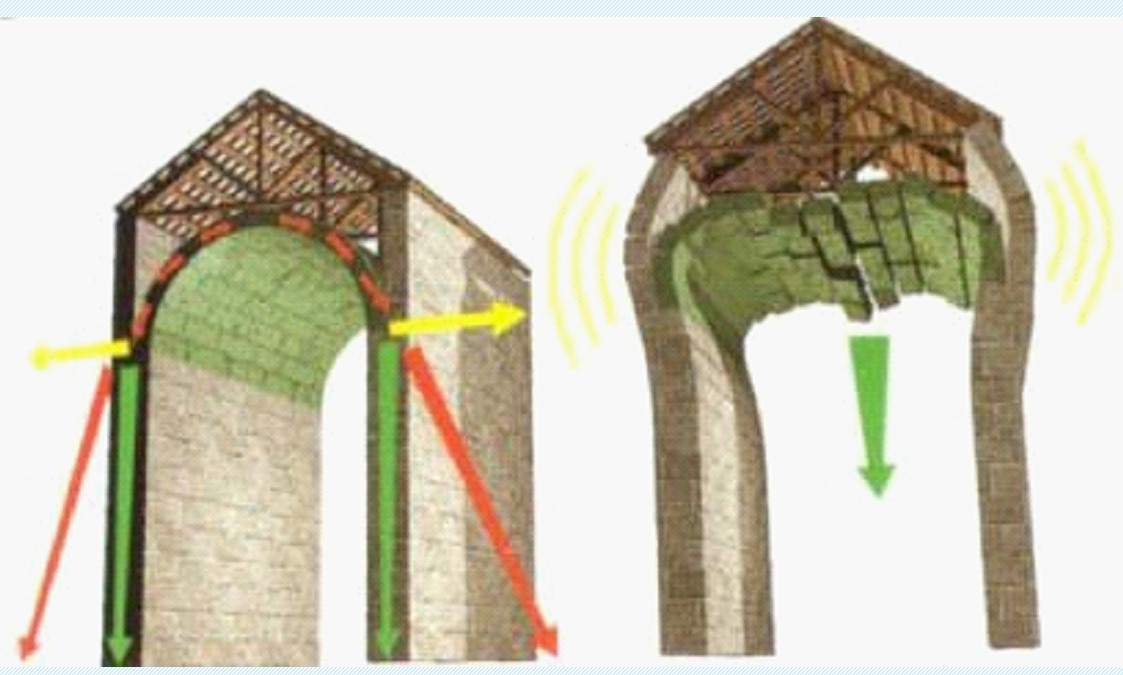 Several problems
had developed with
Romanesque style church. The major
problem was that they easily fell down as builder tried to make them larger.
The rounded arch, while still in use today, could not support the weight
caused by the outward thrust of the rounded arches and ceilings pushing on the
wall. The walls were the main
support of the ceiling therefore they could only have small opening for windows.
So the Romanesque churches were dark and could be rather dreary on the
interior. Having timber roofs, these
churches were subject by fire caused by lightening or sparks from other nearby
building that
was on fire or during a local uprising.
For further information about Romanesque architecture click on my
Romanesque Architecture page.
Several problems
had developed with
Romanesque style church. The major
problem was that they easily fell down as builder tried to make them larger.
The rounded arch, while still in use today, could not support the weight
caused by the outward thrust of the rounded arches and ceilings pushing on the
wall. The walls were the main
support of the ceiling therefore they could only have small opening for windows.
So the Romanesque churches were dark and could be rather dreary on the
interior. Having timber roofs, these
churches were subject by fire caused by lightening or sparks from other nearby
building that
was on fire or during a local uprising.
For further information about Romanesque architecture click on my
Romanesque Architecture page.
THE
BEGINNING OF GOTHIC ARCHITECTURE
In 1122, Suger was elected Abbott
of St. Denis in Paris. Having served as a trusted councilor under his
predecessor, Abbott Adam, he was able to organize the monastery finances,
skillfully manage the abbey’s immense estate and play an important political
role in France. He was minister to
Louis VI and Louis VII, whose biographies he wrote, and Regent during the Second
Crusade (1147-1149).
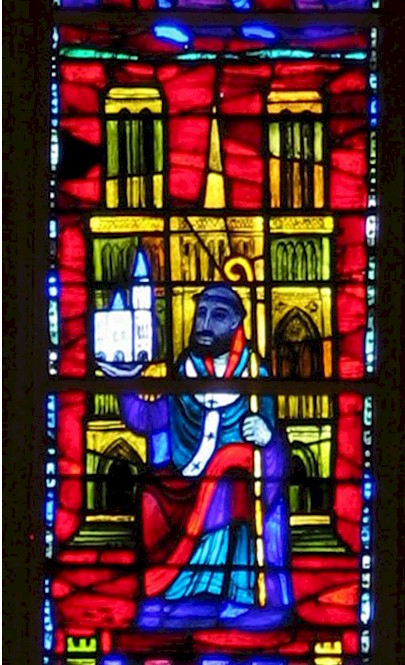 The
stained glass window on the right is in the Washington Cathedral. It
depicts Abbott Suger in front of Notre Dame- Paris hold St. Denis in his right
hand.
The
stained glass window on the right is in the Washington Cathedral. It
depicts Abbott Suger in front of Notre Dame- Paris hold St. Denis in his right
hand.
In 1140, Abbott Suger began a
renovation of St. Denis Abbey which was the beginning of what we now call Gothic
architecture. Suger had a high
theology of light and wanted the abbey filled with light and color.
He first enlarged the ambulatory, the walkway behind the altar.
He did this by using pointed arches instead of the former rounded arches
of the Romanesque style. To these
arches he linked flying buttresses and vaulted ceilings.
These components were all tied together.
So Gothic architecture began with
a flurry. The name Gothic was
later assigned to this style by those who thought that the exterior, with all
those buttresses was ugly, especially those who lived in Italy and had
unpleasant memories of the invaders, the Goths.
“It looks like something those terrible Goths would build.” Thus the
name Gothic stuck.
One of the fun illustrations of
how Gothic system of pointed arches and flying buttresses worked was used with
school children at the Washington Cathedral.
We would have two students of equal size stand facing each other with
their hands locked to form a “ceiling” of a church.
The docent or teacher would then push down on the locked hands and arms
thus causing the student to learn backward.
Those who wanted to be dramatic would actually fall down! Then
we asked two more students to stand behind the first students with their hands
pushing against the shoulders of the students in front of them.
The docent would again push on the upraised hands and arms.
The force of the students being the “buttresses” kept the
“ceiling” from falling in.
GOTHIC ELEMENTS
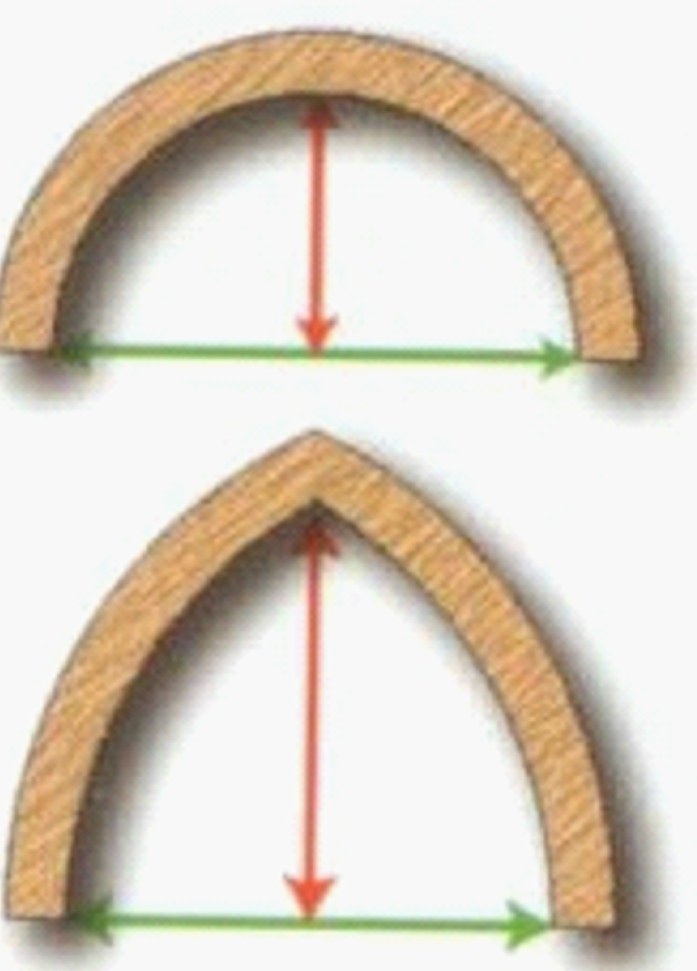 The use of the pointed arch
rather than the rounded arch allowed for great flexibility in the interior
design. The pointed arch could
extend upward to great heights. Pointed
arches would also allow for a greater distance between the columns or piers
beneath them. Also from the
top of these piers were arches that crisscrossed the ceilings and were locked
together by a boss stone. These ceiling were called vaulted. Pushing against
these piers on the outside were the flying buttress.
It all held together. The
weight was not distributed to the wall. The
walls were no longer load bearing so they could have large openings for windows.
Some churches were built with almost totally glass walls such a St.
Chappell in Paris. It has been
said that you could removed all of the walls in a Gothic cathedral, and it would
still stand.
The use of the pointed arch
rather than the rounded arch allowed for great flexibility in the interior
design. The pointed arch could
extend upward to great heights. Pointed
arches would also allow for a greater distance between the columns or piers
beneath them. Also from the
top of these piers were arches that crisscrossed the ceilings and were locked
together by a boss stone. These ceiling were called vaulted. Pushing against
these piers on the outside were the flying buttress.
It all held together. The
weight was not distributed to the wall. The
walls were no longer load bearing so they could have large openings for windows.
Some churches were built with almost totally glass walls such a St.
Chappell in Paris. It has been
said that you could removed all of the walls in a Gothic cathedral, and it would
still stand.
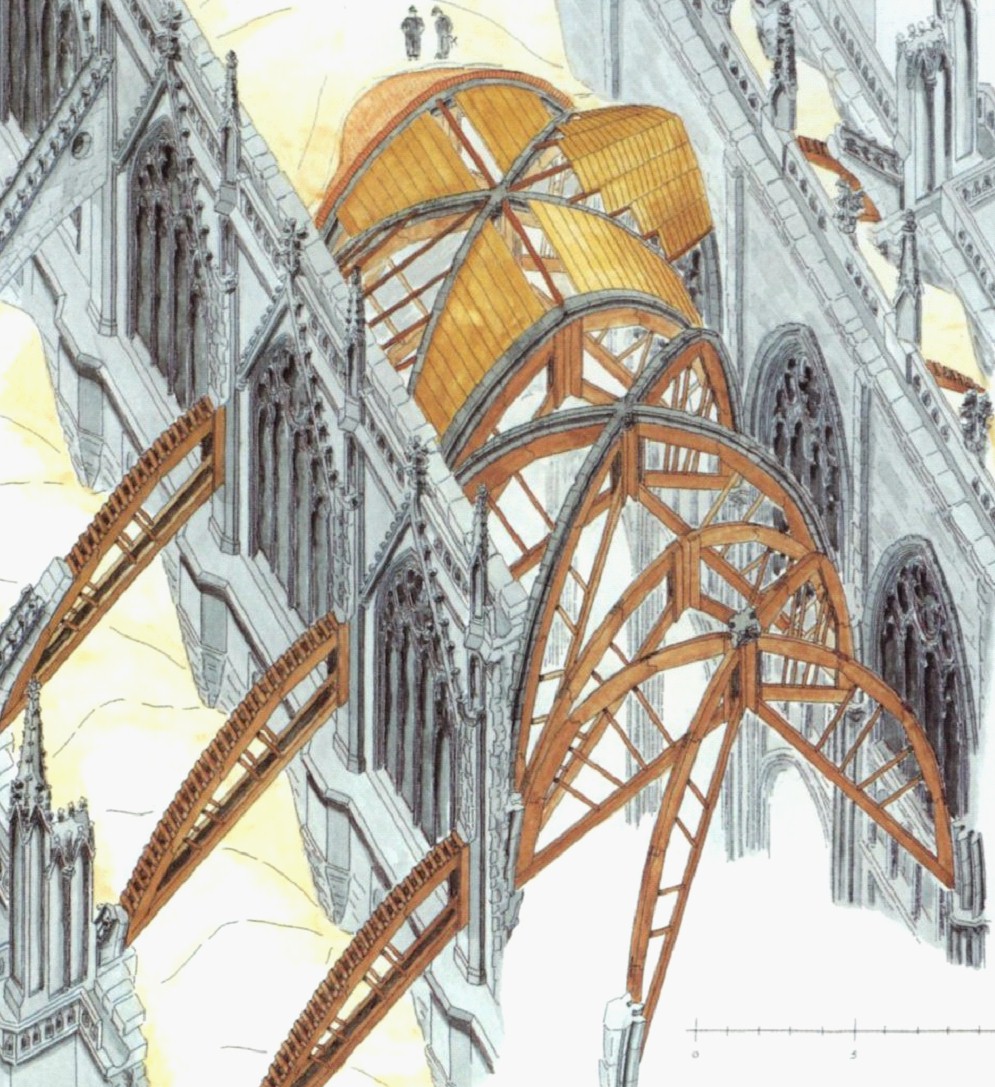

These four elements - pointed
arches, vaulted ceilings, flying buttresses and stained glass windows offered
innumerable possibilities. It is
disheartening to me to hear someone say of the great cathedrals, “if you have
seen one, you have seen them all”. NO!!
They are all different. I have not
experienced any two cathedrals alike. Some
are taller with a triforium level of various designs, in addition to a variety
of clearstory configurations of stained glass. Some
cathedrals are longer than others, some are wider. Even the flying buttresses
take on different shapes. Some
cathedrals have small chapels in the ambulatory that extend
out of the apse in
the back. Some just have small
altars around the ambulatory. Some
have small chapels flanking each side of the nave. As I add pages to Cathedral
Quest, the various “quests” that we have taken and the 133 churches that we
have visited, I will be pointing out
all of the difference in the Gothic syle. The combination of the Gothic elements
are without end.
See a Gothic Elevation.
THE GOTHIC STYLE SPREAD RAPIDLY
 When the people of France saw the
transformation that Gothic architecture brought to St. Denis, everyone wanted
their own Gothic Cathedral. So all
over France great building programs were begun, each with the idea that their
cathedral would be bigger and better than their neighbors.
The first Gothic cathedral in France was in Noyons (1140), followed by
Laon (1145), St. Malo and Dol - de-Bretagne – both in Normandy (1155),
Soissons (1158), Rouen (1160), Notre Dames-Paris (1163), and Chartres (1175). In
the short space of 35 years, eight new cathedrals were begun in France.
Many Gothic churches took hundreds of years to build, so as the old
architect retired or died, the new architect would make changes that suited him.
He was also able to use new technology and materials for the
construction. It is interesting to
see where one architect or period ended and other started in the same church.
Gothic architecture was not limited to new churches.
Older Romanesque churches had their weaker parts rebuilt in the Gothic
style. So we visited churches that were Romanesque and Gothic.
We even experienced some that added some Renaissance and Baroque styles
in their remodeling. Some churches
experienced a number of fires and the parts that were destroyed were rebuilt in
the current style much as we do today when remodeling a home or building.
When the people of France saw the
transformation that Gothic architecture brought to St. Denis, everyone wanted
their own Gothic Cathedral. So all
over France great building programs were begun, each with the idea that their
cathedral would be bigger and better than their neighbors.
The first Gothic cathedral in France was in Noyons (1140), followed by
Laon (1145), St. Malo and Dol - de-Bretagne – both in Normandy (1155),
Soissons (1158), Rouen (1160), Notre Dames-Paris (1163), and Chartres (1175). In
the short space of 35 years, eight new cathedrals were begun in France.
Many Gothic churches took hundreds of years to build, so as the old
architect retired or died, the new architect would make changes that suited him.
He was also able to use new technology and materials for the
construction. It is interesting to
see where one architect or period ended and other started in the same church.
Gothic architecture was not limited to new churches.
Older Romanesque churches had their weaker parts rebuilt in the Gothic
style. So we visited churches that were Romanesque and Gothic.
We even experienced some that added some Renaissance and Baroque styles
in their remodeling. Some churches
experienced a number of fires and the parts that were destroyed were rebuilt in
the current style much as we do today when remodeling a home or building.
There were six periods in the
development of Gothic Architecture:
a.
Early
Gothic (1140 – 1190)
b.
Classical
Gothic (1190 – 1230)
c.
Rayonnant
Gothic (1230 – 1360)
d.
English
Decorated Gothic (1250 – 1350)
e.
English
Perpendicular Gothic (1350 – early 1500)
f.
Flamboyant
Gothic or Late Gothic (1360 – 1500)
GOTHIC CATHEDRALS ARE MORE THAN JUST THE STONES
When one contemplates the great
cathedrals and churches of Europe, we cannot limit our thoughts solely to basic
components of the architecture alone. Even
though I love to read and study the architecture,
I equally enjoy reading medieval history, both factual and historic
novels. I love the medieval
mysteries, most of them involving the church and its clergy in some way.
We have enjoyed studying the art of the period both at the Smithsonian
Resident Associates programs and by viewing lectures produced by the Teaching
Company.
What a wonderful time we had visiting churches where we
saw the art that we had studied such as the Arena Chapel in Padua and the many
churches in Florence.
So these cathedrals and churches
are much more than just brick and mortar. They
are first of all the result of the skill and inspiration of their architects and
builders. Most of these artisans saw the possibility of creating new and
different designs from what another
architect had created in the next town yet using the same components of pointed
arches, vaulted ceilings, flying buttresses, and stained glass.
We can look at these churches ecclesiastically as first of all the seat of the Bishop who held
authority over the clergy and members of the community.
The cathedrals also provided positions for other clergy such as deans and
canons.
Cathedrals can be viewed from a theological position. The
cathedrals after all were built as places of worship and to the Glory of God.
They were thought of as the New Jerusalem.
They conveyed to the visitor a sense of heaven.
I was always moved, as a docent at the Washington Cathedral, when a group of students would walk in
and look up uttering a great big “wow”.
The cathedrals evoked and still evoke a sense of “wow”, a sense of
awe, a sense of the holy, a sense of another world.
The taller and bigger the cathedral the more the “wow”.
The altar is the place of sacrifice as the Eucharist is celebrated time
and time again. Most Gothic
cathedrals are designed so that there is a straight, unobstructed path from the
front door to the altar. You will
find some variations such as in the Spanish cathedrals.
Cathedrals are a place where you feel the presence of God.
In Gothic cathedrals this is also felt in the light streaming through the
stained glass windows. There is a theology of light.
The Gothic cathedrals evoke a lot
of emotional responses in addition to
those just mentioned. The experience
of a great church involves all of our senses.
As many times as I have been in the Washington Cathedral it is
always a new experience just to sit and look at what is surrounding me.
I always found something new, something that would transport me to
another realm of my emotions. There
are the sounds of the cathedral that capture our ears, maybe the organ playing
in the back ground or a choir singing. I
will never forget our experience in St. Remi in Reims.
We were the only people in the church, and the organist was playing very
soft beautiful music. It was literally an awesome experience.
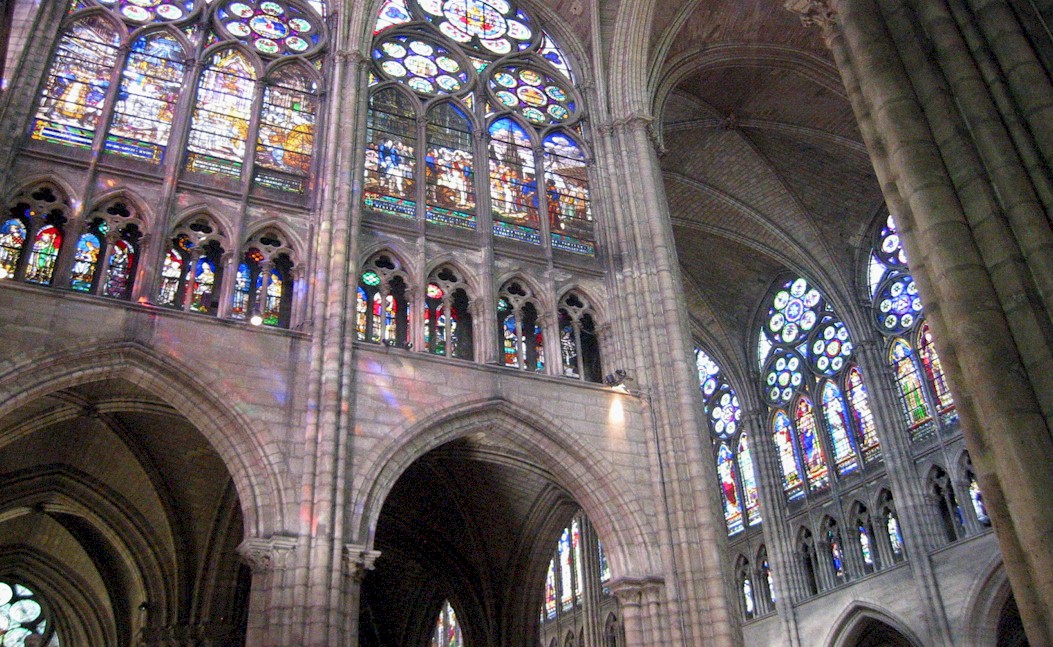 Also cathedrals and other
churches can be looked at artistically.
Because there was so much wall space, without windows, in the Romanesque
churches, paintings soon occupied these space.
The great artists of the Middle Ages filled churches with the wonders of
their religious art work. I would
suggest that you explore what art is in the churches that you plan to visit, and
learn about it before you visit. In
addition to the paintings, there are the wonderful sculptures in stone and wood.
I will point these out as we examine various churches.
One of my favorite forms of art in Gothic churches is the stained glass
windows. It is breath taking to see
walls and wall of beautiful color with the sun shining through and often
reflecting these colors in some unexpected places.
(Picture on the left is at St. Denis). Also we think about music as a form of art that became important to
worship. All of the art and music
were important as a means of education in a time before books.
The paintings, the statues, and the stained glass all told stories from
the Bible, from the history of the church and of the community.
Visitors could “read” the stained glass, a painting or a statue to
enlarge their understanding of the Bible or the church.
Also cathedrals and other
churches can be looked at artistically.
Because there was so much wall space, without windows, in the Romanesque
churches, paintings soon occupied these space.
The great artists of the Middle Ages filled churches with the wonders of
their religious art work. I would
suggest that you explore what art is in the churches that you plan to visit, and
learn about it before you visit. In
addition to the paintings, there are the wonderful sculptures in stone and wood.
I will point these out as we examine various churches.
One of my favorite forms of art in Gothic churches is the stained glass
windows. It is breath taking to see
walls and wall of beautiful color with the sun shining through and often
reflecting these colors in some unexpected places.
(Picture on the left is at St. Denis). Also we think about music as a form of art that became important to
worship. All of the art and music
were important as a means of education in a time before books.
The paintings, the statues, and the stained glass all told stories from
the Bible, from the history of the church and of the community.
Visitors could “read” the stained glass, a painting or a statue to
enlarge their understanding of the Bible or the church.
Cathedrals also became the center
of community life.
That is where people gathered. Often
the cathedrals were used for purposes other than worship.
They were sometimes the place of the market.
Popular music events and
plays were often performed in the church as they are today.
The building of the cathedrals involved the skill and labor of almost
everyone in the community in some way from those who quarried the stone, those
who designed the building, those who were the masons, the stained glass artists
and makers of colored glass, those who wrote the music, those who carved the
statues, those who maintained the building, those who sang in the choir or led
the worship, and those who helped pay for it.
As I describe the seven years of
our quest and the 133 church that we have visited so far, I will point out to
you the differences and similarities in architectural designs. I will describe
and where possible show the art work. I will share our emotions and the
sensations that we have experience. We have had an exciting time on our quests
and are anxious to share these. I
hope that no one will say, “once you have read about one, you have read about
them all”.
Below is a list of the Gothic churches that we have visited. As I write about these churches on the various travel pages, I will provide a link from the church listed below to a full description of that particular church.
|
|
|
GOTHIC 1140-1300
|
|
|
Present
|
Finsh
|
City
|
Country
|
Church Name
|
Started |
Date
|
|
|
|
1140
|
1281
|
Paris
|
France
|
St. Denis
|
1145
|
|
Dol
|
France
|
Cathedrale St. Samson
|
1145
|
1235
|
Noyon
|
France
|
Notre Dame
|
1150
|
1240
|
Laon
|
France
|
Notre Dame
|
1150
|
|
Cologne
|
Germany
|
Gross St. Martin
|
1155
|
|
St. Malo
|
France
|
Cathedrale St. Vincent
|
1156
|
|
Maria Laach
|
Germany
|
Maria Laach
|
1158
|
1479
|
Soisson
|
France
|
Notre Dame
|
1160
|
1345
|
Rouen
|
France
|
Notre Dame
|
1163
|
1460
|
Canterbury
|
England
|
Canterbury Cathedral
|
1163
|
1218
|
Paris
|
France
|
Notre Dame
|
1174
|
1322
|
Wells
|
England
|
Wells Cathedral
|
1175
|
1506
|
Chartres
|
France
|
Notre Dame
|
1176
|
|
Strosbourg
|
France
|
Catheral
|
1180
|
|
Paris
|
France
|
St.Germain des Pres
|
1194
|
|
Rouen
|
France
|
Abbaye
St. Ouen
|
1200 |
|
Barcelona |
Spain |
Cathedral |
1200
|
|
Reims
|
France
|
St. James
|
1200
|
|
Freiburg
|
Germany
|
Freiburg Cathedral
|
1200
|
1452
|
Florence
|
Italy
|
San Marco
|
1200
|
1300
|
Vitoria
|
Spain
|
Cathedral de Santa Maria
|
1211
|
1400
|
Reims
|
France
|
Notre Dame
|
1211
|
1263
|
Siena
|
Italy
|
Siena Cathedral
|
1220
|
1280
|
Salisbury
|
England
|
Cathedral Church Blessed
Virgin Mary
|
1220
|
1280
|
Amiens
|
France
|
Notre Dame
|
1220
|
|
Cologne
|
Germany
|
St. Andreas
|
1221
|
1521
|
Burgos
|
Spain
|
Santa Maria Cathedral
|
1225
|
1573
|
Beauvais
|
France
|
St. Pierre
|
1225
|
|
Venice
|
Italy
|
Giacomo dell Orio
|
1226
|
1493
|
Toledo
|
Spain
|
Cathedral
|
1235
|
|
Trier
|
Germany
|
Liebffraunenkirche
|
|
|
1236
|
Cordoba
|
Spain
|
Mosque/Cathedral
|
1242
|
1248
|
Paris
|
France
|
Sante Chapelle
|
1245 |
1430 |
Venice |
Italy |
Zanepolo |
1252
|
1282
|
Valencia
|
Spain
|
Cathedral
|
1055
|
1272
|
London
|
England
|
Westminster Abbey
|
1402
|
1506
|
Seville
|
Spain
|
Cathedral of Santa Maria
del Sede
|
1499 |
1600 |
Bath |
England |
Bath Abbey |
1525
|
1768
|
Segovia
|
Spain
|
Segovia Cathedral
|
|
|
|
|
|
|
